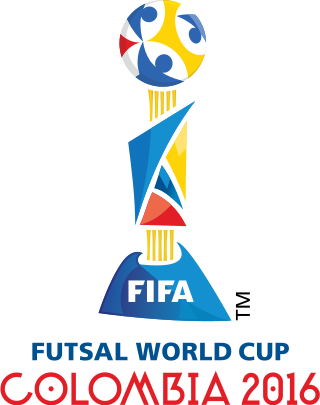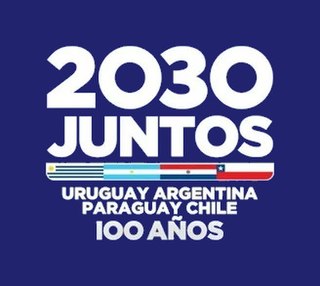
The Ecuador national football team represents Ecuador in men's international football and is controlled by the Ecuadorian Football Federation (FEF). They joined FIFA in 1926 and CONMEBOL a year later.

The Estadio Nemesio Camacho El Campín, commonly known as El Campín, is the main stadium of Bogotá, Colombia. It was inaugurated on 10 August 1938 and has a current capacity of 39,512 spectators. It is the home ground of the Categoría Primera A teams Millonarios and Santa Fe.

Ibagué is the capital of Tolima, one of the 32 departments that make up the Republic of Colombia. The city is located in the center of the country, on the central mountain range of the Colombian Andes, near Nevado del Tolima. It is one of the most populous cities in the country, with a population of 492,554, making it the eleventh most populous in Colombia, and with a population of 529,625 in the municipality. It was founded on 14 October 1550, by the Spanish captain Andrés López de Galarza. The city of Ibagué is divided into 13 communes and the rural area has 17 corregimientos. As the capital of the department of Tolima the city hosts the Government of Tolima, the Departmental Assembly, and the Attorney General's Office. It is the main epicenter of political, economic, administrative, business, art, culture, and tourism activities in the area.

The Estadio Mario Alberto Kempes, formerly known as Estadio Córdoba, is a stadium in the Chateau Carreras neighborhood of Córdoba, Argentina. Owned by the Córdoba Province, the venue is used mostly for association football and rugby union matches and also sometimes for athletics.

The Estadio Gran Parque Central is the stadium of Club Nacional de Football. It is located in Montevideo, Uruguay, near Nacional headquarters, in the La Blanqueada neighbourhood.

Estadio Regional de Antofagasta, officially Estadio Regional Bicentenario Calvo y Bascuñan de Antofagasta, is a sport facilities complex located in Antofagasta, Chile. The municipality of Antofagasta is the owner of the building and it used to host sports events such as cultural events and entertainment events. The complex is composed of the Main Stadium who is use made for most important events. The secondary fields, 1, 2, 3 and 4, are used for training sessions. The Field 5 is used to secondary events, with football pitch dimensions and counts with a Baseball field where are made the regional tournaments of this sport.

Estadio La Independencia is a multi-use stadium in the city of Tunja, Colombia. It is currently used mostly for football matches. The stadium has a capacity of 25,000 people, and is 2,800 metres above sea level. Boyacá Chicó and Patriotas play their home games at this stadium.

Hernán Darío Gómez Jaramillo, also known as El Bolillo, is a Colombian football manager and former player who played as a defensive midfielder. He is the current manager of Colombian club Águilas Doradas.
Internacional Fútbol Club de Palmira, officially named Cortuluá Fútbol Club S. A. and previously known as Corporación Club Deportivo Tuluá or Cortuluá for short, is a Colombian football club from Palmira, Valle del Cauca. It was founded in 1967 in the municipality of Tuluá, Valle del Cauca Department and plays in Categoría Primera B, the second-tier competition of Colombian football.

This article concerns the process for determining the host nation of the 2014 FIFA World Cup, which concluded on 30 October 2007 with the confirmation of Brazil as the hosts.
Estadio San Juan del Bicentenario is a football stadium located in the Pocito Department of San Juan Province, Argentina. Owned by the Government of San Juan Province, it currently hosts the home matches of local clubs San Martín, Sportivo Desamparados, and others. The stadium also served as venue for the 2011 Copa América. Estadio San Juan del Bicentenario was designed with a capacity of 25,000 spectators and required an investment of AR$86 million.

The 2016 FIFA Futsal World Cup was the eighth FIFA Futsal World Cup, the quadrennial international futsal championship contested by the men's national teams of the member associations of FIFA. The tournament was held in Colombia from 10 September to 1 October 2016.

The Uruguay–Argentina–Chile–Paraguay 2030 FIFA World Cup bid, also known as the South American Bid or simply the South Bid, was an unsuccessful joint bid to host the 2030 FIFA World Cup by Uruguay, Argentina, Paraguay and Chile. The tournament's name would be Centenary World Cup.

Estadio Atanasio Girardot, commonly referred to as El Atanasio, is a multi-purpose stadium in Medellín, Colombia.

The 2022 Copa América Femenina was the 9th edition of the main international women's football championship in South America, the Copa América Femenina, for national teams affiliated with CONMEBOL. The competition was held in Colombia from 8 to 30 July 2022.

The Colombia bid for the 2023 FIFA Women's World Cup was a unsuccessful bid to host the 2023 FIFA Women's World Cup by Colombian Football Federation. The single bid was announced on 12 December 2019. The bid entailed playing at 10 venues in 10 host cities, with the final held at the Estadio El Campín in Bogotá.

The Estadio Único Madre de Ciudades is a stadium located in the city of Santiago del Estero in the homonymous province of Argentina. The stadium was inaugurated on March 4, 2021, before the 2019 Supercopa Argentina match contested by River Plate and Racing Club. President of Argentina Alberto Fernández attended the ceremony.
The 2023 South American U-20 Championship was the 30th edition of the South American U-20 Championship, the biennial international youth football championship organised by CONMEBOL for the men's under-20 national teams of South America. It was held in Colombia between 19 January and 12 February 2023.

The 2022 Copa América Femenina Final was a football match on 30 July 2022 that took place at Estadio Alfonso López in Bucaramanga, Colombia, to determine the winners of 2022 Copa América Femenina. The match took place between hosts Colombia and Brazil.

















